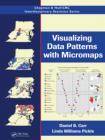Visualizing Data Patterns with Micromaps
Carr, Daniel B. / Williams Pic
Éditeur : CRC PRESS
ISBN papier: 9781420075731
Parution : 2010
Code produit : 1134720
Catégorisation :
Livres /
Science /
Mathématique /
Mathématiques
Formats disponibles
| Format | Qté. disp. | Prix* | Commander |
|---|---|---|---|
| Livre papier | En rupture de stock** |
Prix membre : 70,78 $ Prix non-membre : 74,50 $ |
*Les prix sont en dollars canadien. Taxes et frais de livraison en sus.
**Ce produits est en rupture de stock mais sera expédié dès qu'ils sera disponible.
Description
After more than 15 years of development drawing on research in cognitive psychology, statistical graphics, computer science, and cartography, micromap designs are becoming part of mainstream statistical visualizations. Bringing together the research of two leaders in this field, Visualizing Data Patterns with Micromaps presents the many design variations and applications of micromaps, which link statistical information to an organized set of small maps. This full-color book helps readers simultaneously explore the statistical and geographic patterns in their data. After illustrating the three main types of micromaps, the authors summarize the research behind the design of visualization tools that support exploration and communication of spatial data patterns. They then explain how these research findings can be applied to micromap designs in general and detail the specifics involved with linked, conditioned, and comparative micromap designs. To compare and contrast their purposes, limitations, and strengths, the final chapter applies all three of these techniques to the same demographic data for Louisiana before and after Hurricanes Katrina and Rita. Supplementary website Offering numerous ancillary features, the book’s website provides many boundary files and real data sets that address topics, such species biodiversity and alcoholism. One complete folder of data examples presents cancer statistics, risk factors, and demographic data. The site includes CCmaps, the dynamic implementation of conditioned micromaps written in Java, as well as a link to a generalized micromaps program. It also contains R functions and scripts for linked and comparative micromaps, enabling re-creation of all the corresponding examples in the book.























